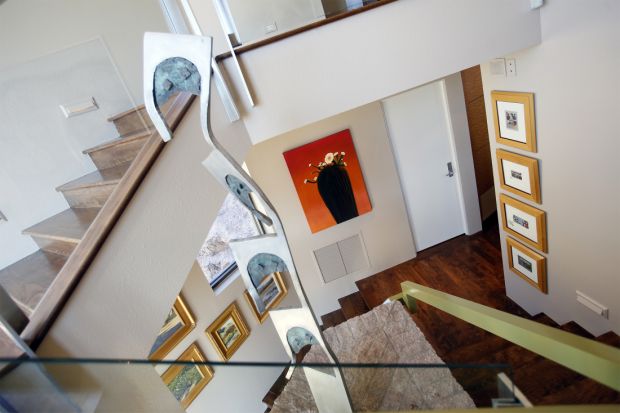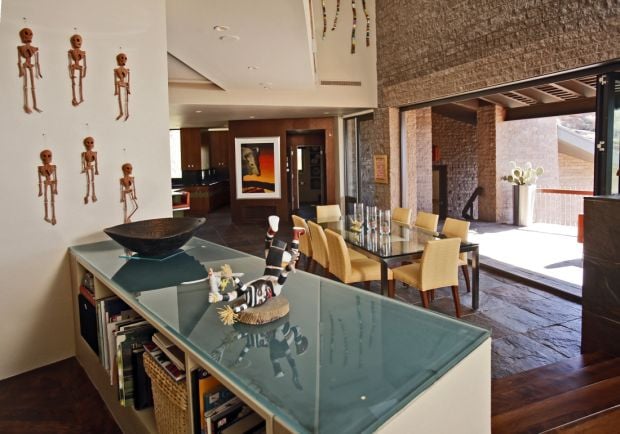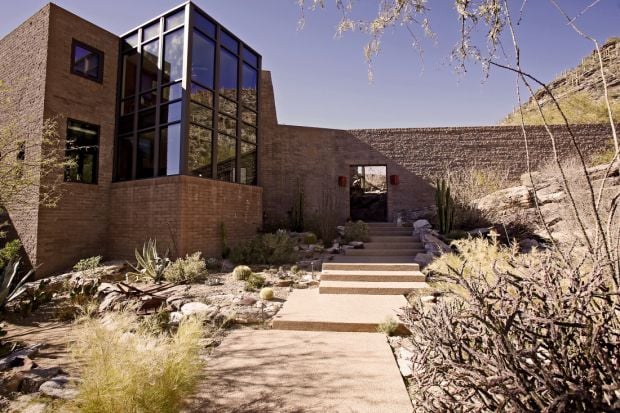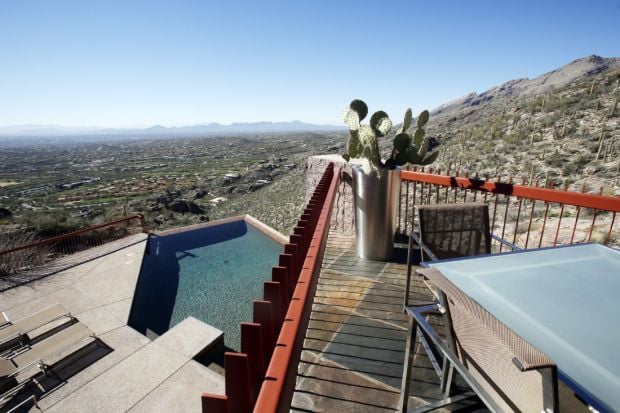Perhaps you’ve noticed it high up on the side of the mountain, a glint of light reflecting the afternoon sun.
Even as you approach, it’s hard to make out this home, carved into the mountain. It’s said to be the highest home in the Santa Catalina Foothills, and at 3,550 feet, it’s nearly a cool 1,000 feet above the city.
Built in the 1970s on pristine mountain terrain, the house sits on 93 acres of deeded land backing up to the Coronado National Forest. It blends in so well with the mountains that developers of Loews Ventana Canyon Resort sought advice from the home’s original owner, who used dynamite to blast a road to his property four decades ago.
“The goal was to make it blend in as much as possible,” said sculptor Fred Borcherdt, who helped plan, design and build much of the home for himself and his wife, artist Lynn Taber.
In 1970, the couple bought land in the area of what is now Ventana Canyon Golf & Racquet Club, and lived in an old, quirky home that was part of the original homestead. They had the desert virtually to themselves.
While hiking the mountain, Borcherdt discovered a piece of paradise, a spot he thought would make the perfect setting for his home. There was no road, no water, no electricity — only a gorgeous chunk of mountain with views that seemed to go on forever.
“Early on I realized the extent of the undertaking was pretty overwhelming,” Borcherdt said.
But he didn’t give up, and seven years later, he and his wife moved into their home high above the desert floor.
For the second time since it sprang from rock all those years ago, the house is for sale, with a price tag of $4.5 million. It is one of 10 homes currently for sale in the Tucson area listed at $3 million or more.
“This is a home that virtually everyone who has lived in the Catalina Foothills during the past 35-plus years has likely wondered about,” said David Henry of Long Realty. “It truly is unique.”
The journey was not a simple one for Borcherdt and his wife. It involved years of planning, backbreaking work and lots of dynamite.
Borcherdt grew up near Chicago and came to Tucson to attend the University of Arizona in 1957. He went on to the Art Institute of Chicago, but in 1970, the desert called him back, and he returned with his wife.
Living in the old homestead home, Borcherdt spent hours exploring the foothills that rose up before him, and discovered the spot. There was nothing between the property and Sunrise Drive but acres of pristine desert land.
He bought more land, eventually owning 130 acres. He bought a bulldozer, a rock drill and an air compressor and got to work. He sought advice and help from others who had pioneered rocky terrain.
An old scrapbook is filled with photos documenting the project, including snapshots of Borcherdt running from dynamite blasts as the road was built.
“It was a high learning curve,” he recalled. “I learned on the job.”
It took nearly four years to blast the road and lay the water line that fed off a well Borcherdt owned in Esperero Canyon.
Everywhere he blasted — each time with approval from the Pima County Sheriff’s Department, he added — a white scar was left behind. Borcherdt bought old paint and mixed it up to create shades of gray, which he used to paint the scarred mountainside.
“I was trying not to make a big footprint on the side of the mountain,” he recalled.
During those years, Borcherdt was blasting by day, sculpting at night.
After the infrastructure was in place, a local architect and builder built the home, with help from Borcherdt. It is unique in that it was built on rock.
“At that time, no one in the Foothills built a house on solid rock that I knew of,” Borcherdt said. The home was built around rock outcroppings that found a home inside.
“We made a rock garden inside, and we grew tropical plants and moss, and kept it moist,” Borcherdt said. “It was great. It kept the humidity up in the house.”
The home was constructed with split face block — the same material used to build Ventana Canyon Resort a decade later.
It was filled with interesting angles and concepts. The living room floor flowed onto the dining room table in this three-story house split into five levels.
Borcherdt also built a stable, corral and tack room for his horse. “I wanted to make a home for him, too.”
The greatest challenge?
“Getting my wife to ride the road,” he said of the steep — but now well-paved — road.
The couple shared many happy years there.
“It was a great inspiration and had tremendous impact on our work,” Borcherdt said of the house. “Lynn got into painting clouds and sky. I got into using rock in my sculpture.”
But the secret was soon out about this gorgeous land.
“At first I thought we would be there forever but the development came and the ruralness disappeared, and we were looking at a golf course and people in golf carts,” Borcherdt said.
The couple now lives on a ranch north of Willcox, and maintains a home in Tucson.
In 1999, the house was bought as a second home by now-retired Chicago executive search consultants Fred Wackerle and Barbara Provus.
The couple also owns a high-rise home in Chicago and had been coming to Tucson since the 1980s. “Whenever I played golf at Ventana I would look up and wonder who owned that beautiful home up there,” Wackerle said.
They owned a home in Tucson, but were looking for something with more land. When the Foothills house became available, they were drawn to it. But it was just 2,800 square feet, and they were hoping for something larger.
Architect Michael Franks investigated whether the home could be expanded, and in 2000, the couple spent $1.8 million gutting the interior and doubling the home in size, with L.J. McCreary performing the reconstruction.
Only the original walls remained. The couple removed the interior rock, with the exception of a wall of rock that remains behind closed doors in a utility room.
They added a pool, patios, landscape and hardscape. They blew out the dining room wall and added a huge accordion glass door that opens up to the southern patio, overlooking the valley and surrounding mountain ranges.
Vibrant, eclectic art they have collected over the years fills the contemporary home, decorated in shades of citrus.
In a desert spot not far from the pool sit two seats that were once the couple’s seats at Chicago Cubs baseball games. When Wrigley Field was remodeled, the couple bought their seats and brought them here.
A watering hole below attracts wildlife, including mountain lions, coatimundi and tortoises.
“Aside from the drama of the great view, we just love the privacy, the isolation, being so close to wildlife, overlooking the beautiful city,” said Wackerle, an oil painter who finds inspiration in the attached studio/guesthouse that the previous owner used as her studio.
“It’s just magnificent,” he continued. “It’s a very hard home to leave, but we are going through a downsizing phase in our lives. It’s bittersweet.”
Realtor Henry says the property offers unique architecture and the best views in town.
“The owners have told me coming here is like nutrition for your soul,” Henry said. “I don’t know of anything else like it in Tucson.”









